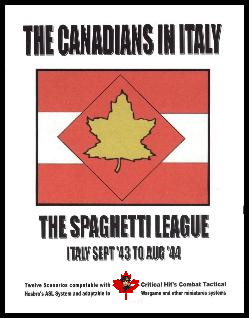

The second pack of the Canadians in Italy series, has the Canadians landing on the Italy peninsula and advancing northwards towards the Rome. This 12 scenario pack is compatible with MMP's ASL System.
9 FIRST CLASH: The Canadians splashed ashore at 0430 hours, 3 September; the fourth anniversary of Britain's declaration of war. The Canadians had landed in continental Europe- Hitler's celebrated Festung Europa, without being shot at or suffering a single causality. It was ideal countryside for delaying tactics, executed with excellence by German demolition teams. Steady, if slow progress was made by the Canadian division. The first clash was in Gambarie, a ski resort in a pine forest, was defended not by Germans, but Italians- Fascist militia known as "Black Shirts".
10 PER L'ONORE D'ITALIA: The Second Brigade now moved into the lead, striving to reach Cittanova, a large town on Route 111, one of the lateral highways which crosses the Aspromonte from coast to coast. When the Princess Patricia's Canadian Light Infantry were slowed by demolitions along Route 112, Brigadier Chris Vokes sent the Loyal Edmonton Regiment cross-country along a doubtful track which might lead to Cittanova. The Eddies also ran into Italians troops, a hundred German-trained paratroopers of the elite 184th (Nembo) Division, who surprised the Canadians by putting up a spirited fight.
11 MONTY'S MOUNTAIN GOATS: Campobasso, a picturesque city nestled in the eastern foothills of the Apennines was the Canadian objective. Twelve miles from Lucera, Route 17 climbed rapidly. The Princess Louise's Dragoon Guards armoured cars came under heavy machine-gun and shellfire shortly after 0800 hours and the Canadians deployed for a tank-infantry assault. The tank broke into Motta but the infantry were soon pinned down by German artillery and machine-guns.
12 CROSSING THE MORO: The First Canadian Division commander, Chris Vokes after studying patrol reports decided to establish a bridgehead and chose to cross the Moro at three points. The bridgeheads; on Route 16 near the mouth of the Moro, at San Leonardo and at Villa Rogattia village two miles upstream from San Leonardo. The Hasty Ps were to cross the Moro on the right, while the Seaforth of Canada took San Leonardo in the centre and the PPCLI on the left were to capture the village of Villa Rogatti, two miles upstream from San Leonardo. The only clear-cut success was gained by the PPCLI who had slipped across the Moro at an unguarded ford and by dawn had captured the village in a short but savaged battle. When morning came, the Germans launched their first counter attacks along the Moro producing mixed results, and still unable to dislodge Major W.D. "Bucko" Watson and his company as they stood firm on the north bank.
13 STERLIN CASTLE: By nightfall on 6 December, the Canadian division was across the Moro in two places. The only practicable site was the demolished bridge on the road to San Leonardo. The afternoon of 8 December the First Brigade launched a two-prong assault on San Leonardo with the RCR right hooking out of the Hasty Ps bridgehead while the 48th Highlanders of Canada would cross the Moro and attack La Torre midway between Villa Rogatti and San Leonardo. Attacking southwestwards along a long winding lane soon to be dubbed "Royal Canadian Avenue" the RCR would attack across the front of the Panzergrenadier Regiment 361. The Germans retreated and San Leonardo was at last secured, but counter-attack were the order of the day and on Thursday, 9 December, the German counter-attacked. Again and again the Germans swarmed around Sterlin Castle.
14 TWO SHOOTING DAYS TILL CHRISTMAS: While the Second Brigade slogged its way yard by heartbreaking yard through Ortona's streets and alleys, General Vokes had launched an outflanking attack two miles west of the battered town. The First Brigade was to commit its three-infantry battalions supported by the tanks of the Ontario Regiment in succession. The Hastings and Prince Edward Regiment, the Hasty P's would lead the attack, but the two-lead assault companies soon became bogged down in the face of heavy fire. Seeing the difficulties newly promoted Lieutenant-Colonel Bert Kennedy, charged forward running a gauntlet of bullets and shellfire without so much as hunching his shoulders. Kennedy quickly organized a new assault, moving up one of his reserve companies and putting out a call for the Ontario Shermans, churning in the mud somewhere to the rear.
15 SWEET REVENGE: The Canadian Army's first action of 1944 on the Adriatic front was fought by the Carleton and York Regiment exacting sweet revenge for its New Year's setback at the hands of those tough paratroopers. At Point 59, overlooking Torre Mucchia on the coast, the Germans had established two strongpoints, defended by a half-dozen machineguns and linked by trenches, protected by barbed wire and minefields. After a daylong bombardment, a single company of Carletons attacked from two directions.
16 HONOUR AND GLORY: The Eleventh Canadian Infantry Brigade of the Fifth Armoured Division moved up on 12 January to relieve the weary Third Brigade and with that the First Canadian Corps had become fully operational in the Italian theatre. The brigade patrol program was barely under way when a dramatic change of plan took place. This operation to be supported by all artillery available. The Perths Regiment went in first, at 0545 hours. C-Company remained pinned down, except for a party under Lieutenant Robert Chamberlain. After fording the Ricco, Chamberlain's platoon had wiped out a three-man machine-gun post and moved up the ridge
17 HEART OF OAK: The western Canadians of the Second Infantry Brigade walked into disaster. For Princess Patricia's Canadian Light Infantry on the right, supported by the Loyal Edmonton Regiment with the Seaforth Highlanders of Canada on their left. Major Watson's company reported that it was past the barbed wire entanglements that marked the leading edge of the Hitler Line. Unable to move forward, the tanks present wonderful targets to the Panzerturms mounting 75mm guns. As tank after tank brewed, the survivors were forced to fall back to the dubious protection of the woods. At every step men fell; some were victims of Nebelwerfer fire, many were dropped by machinegun bullets and others trod on mines scattered about the barbed wire entanglements.
18 THE ROAD TO ROME: By the evening of 23 May, the Anzio beachhead suddenly coming to life and posing a threat to the German Tenth Army's line of communications. As the German defences crumbled, there was only one possibility of stabilizing the situation in the Liri valley. Six miles northwest of the ruptured Hitler Line, a little river meandered across the floor of the valley. Its name was the Melfa, and if the Germans could hold it, the German Tenth Army might yet be saved. Vokes Force, commanding by Lt-Colonel Vokes and consisting of his British Columbia Dragoons and the Irish Regiment of Canada would go about halfway to the Melfa and then allow Griffin Force to pass through. Vokes Force plunged into action 0757 hours on 24 May. The B-Squadron, BC Dragoons became the first Allied force to engage Mark V Panther tank. Lieutenant Taylor never forgot his shock at seeing the Panther, but fortunately he spotted the Panther before the German saw him.
19 GLORIOUS SUMMER DAY: The Perths entered undefended Arnara, two miles northwest of Pofi. Beyond lay three hills code-named "Tom", "Dick", and "Harry". The first two were taken with little difficulty by the Cape Breton Highlanders of Canada and the Irish Regiment of Canada respectively, and the 8th Hussars reached Ceccano. German forces were reported retreating along Route 6 and the Strathconas were ordered to cut them off. They were greeted at the crossroads near the village of Torrice by tanks, self-propelled guns and mounted infantry of the 26. Panzer Division, desperately trying to keep open this vital lin
20 THE BLACK DEVILS OF ANZIO: Canadian soldiers were among the first to enter Rome. The Black Devils of the Canadian-American First Special Service Force (FSSF), who arrived in the embattled Anzio beachhead on 1 February, were the first liberators to enter the city. At 0630 hours, half an hour after the start of the Canadian assault on the Hitler Line , the US VI Corps burst out its trap and launched a drive towards Valmontone. That morning the FSSF with its right flank resting on the Canale Mussolini, punched towards Route 7, the fabled Via Appia, one of the two highways to Rome from the south. The Force reached the road, but a counter attack by a half dozen tanks checked any further advance that day. The tanks included a new and unbelievable monstrosity, Tiger.
Map Boards Required: 4, 10, 13, 16, 17, 33, 39, 40, 43, 44, 46, 50, & HoB I & II